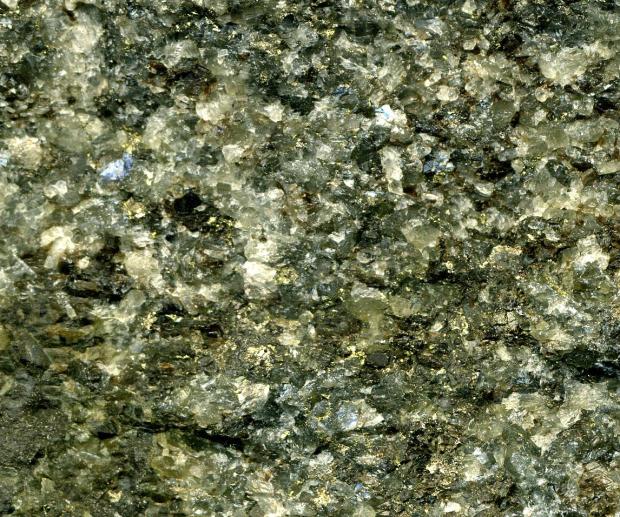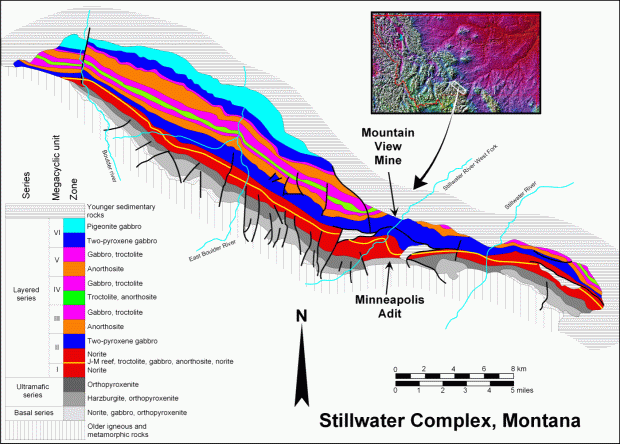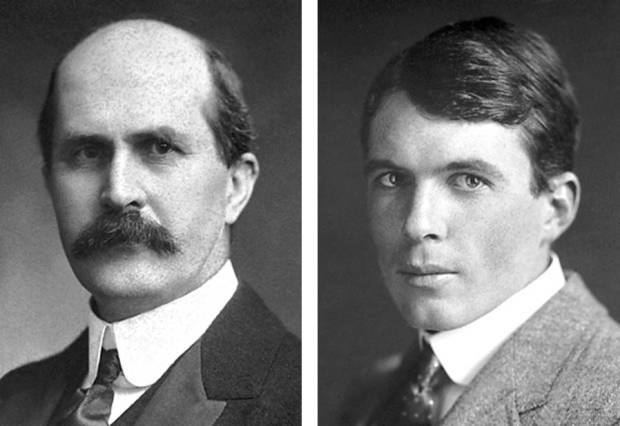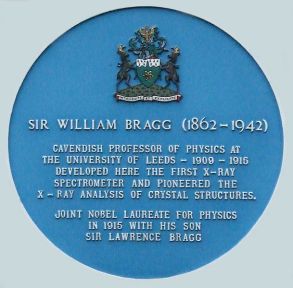Sir William H. Bragg was mentioned a few times in last week’s post so I thought it would be a good idea to talk about his namesake mineral. Braggite is named after him and his son, Sir William L. Bragg. It was discovered in a sample from the Bushveld Igneous Complex, South Africa in 1932 and was the first mineral to be discovered by x-ray methods. This makes braggite the perfect namesake mineral for the Braggs since their work contributed greatly to the development of x-ray crystallography.

Braggite from the Stillwater Complex, Beartooth Mountains, Montana, USA (image from rruff.info)
Quick facts:
- Sulphide mineral
- Found in norite in layered mafic intrusions
- Type locality: Mokopane, Waterberg District, Bushveld Igneous Complex, Limpopo Province, South Africa
- Formula: (Pt,Pd,Ni)S
- Crystal system: Tetragonal
- Hardness: 5
- Density: 10 g/cm3
Braggite is an economically important platinum group mineral and contains 64% platinum, 27% palladium and 14% nickel (based on electron probe analysis). Its composition lies between platinum-rich cooperite and palladium-rich vysotskite which are both end members in a solid solution. When a solution is cooled, cooperite forms the first solid at 1100°C, followed by braggite at 1000°C and then vysotskite at temperatures below 900°C. The crystal structure of braggite was determined 41 years after its discovery by Childs and Hall.

2.71 billion year old norite from the Stillwater Complex, image is 4.5cm across (image by James St. John from commons.wikipedia.org)
Braggite forms at high magmatic temperatures and occurs in norite which is a mafic, intrusive rock. The norite sample pictured above contains pyrrhotite (brownish bronze), chalcopyrite (brassy yellow), plagioclase (grey) and bronzite pyroxene (dark crystals). Norite is found in layered mafic intrusions which are lens-shaped bodies of igneous rock with compositional and/or textural layering. The ideal stratigraphic sequence consists of ultramafic peridotite and pyroxenite at the base with norite, gabbro and anorthite in the upper layers. These intrusions are commonly found in cratons, can cover an area between 100-50,000km2 and are between hundreds of metres to over 1km in thickness.

Geological map of the Stillwater Complex (image from minerva.union.edu)
The braggite sample in the first image comes from the Stillwater Complex which is 48km long and 6.5km thick. 2.71 billion years ago, the complex was intruded into gneiss. After this, the area was intruded by quartz monzonite stocks and mafic dykes and was subjected to metamorphism, folding and faulting. The complex can be split up into three parts:
- A basal zone of fine-grained gabbro with norite and pyroxenite above it; up to 210m thick
- An ultramafic zone with alternating dunite, chromite, harzburgite and bronzite pyroxenite; average thickness of 1100m
- A banded zone of norite, gabbro and anorthoite; up to

Sir William H. Bragg (left) and Sir William L. Bragg (right) (image from nobelprize.org)
W. H. Bragg was born in Westward, Cumbria, England on 2nd July 1862. In 1885, he graduated from the University of Cambridge with a first class honours in the mathematical tripos. A year later, he became a professor in mathematics and experimental physics at the University of Adelaide in Australia. He and his wife Gwendoline Todd had three children; W. L. Bragg was their first son and was born on 31st March 1890. After developing an interest in Wilhelm Röntgen’s work, W. H. Bragg carried out a demonstration in 1896 showing “the application of x-rays to reveal structures that were otherwise invisible”. He produced short bursts of x-rays by using a Crookes tube, an induction coil and a battery. During this demonstration, W. H. Bragg took an x-ray of his hand which revealed an injury from his childhood in Cumbria. During his time at the university, student numbers quadrupled and great improvements were made in the science department. W. L. Bragg was an avid shell collector during his childhood and had around 500 species from South Australia. When he was 17, he discovered a new species of cuttlefish in Glenelg, Australia which was named Sepia braggi in his honour.

Blue Plaque on the Parkinson Building, University of Leeds (image by Cj1340 from wikipedia.org)
In 1909, the family returned to England after W. H. Bragg accepted a position at the University of Leeds as a professor of physics. W. L. Bragg began his degree in maths at the University of Cambridge, but he later switched to physics and graduated with a first class honours in 1911. After being inspired by Max von Laue’s discovery that diffraction patterns form when x-rays pass through crystals, the Braggs began their research which would lead to a Nobel Prize in physics. W. H. Bragg invented the ionisation spectrometer between 1912 and 1913 and used it to study crystal structures. During this time, the Braggs developed the study of x-ray crystallography and discovered that crystalline solids produce patterns of reflected x-rays. W. L. Bragg proposed Bragg’s law which is used to calculate the positions of atoms in a crystal based on how x-rays are diffracted by the crystal lattice. In 1915, father and son won the Nobel Prize in physics “for their services in the analysis of crystal structure by means of x-rays”. This made W. L. Bragg the youngest Nobel Laureate in physics as he was just 25 years old at the time. Their Nobel-winning work showed the relationship between the wavelength of x-rays, the angle of incidence of these rays and the distance between atomic layers in a crystal.
After their Nobel Prize win, W. H. Bragg was appointed professor of physics at UCL in 1915 but didn’t take up the post until after World War One. During his time at UCL, he continued to study crystal structures, was knighted in 1920 and invited Dame Kathleen Lonsdale to work with his research team. In 1923 he became a professor of chemistry at the Royal Institution and the director of the Davy-Faraday Research Laboratory. He died on 12th March 1942. W. L. Bragg became a professor of physics at the University of Manchester (1919-1937). He married Alice Hopkinson in 1921 and had four children. While he was a professor of experimental physics at Cambridge (1938-1953), he was knighted in the 1941 New Year Honours. In 1953, he became the director of the Royal Institution. W. L. Bragg died on 1st July 1971.
References
http://www.mindat.org/min-751.html
https://en.wikipedia.org/wiki/Layered_intrusion
Click to access Lecture%2011%20Layered%20intrusions.pdf
http://plaza.ufl.edu/stroud/Site/Stillwater.html
https://en.wikipedia.org/wiki/Stillwater_igneous_complex
https://en.wikipedia.org/wiki/William_Henry_Bragg
https://en.wikipedia.org/wiki/William_Lawrence_Bragg
http://www.nobelprize.org/nobel_prizes/physics/laureates/1915/wh-bragg-facts.html
http://www.nobelprize.org/nobel_prizes/physics/laureates/1915/wl-bragg-facts.html
http://www.rigb.org/our-history/iconic-objects/iconic-objects-list/bragg-spectrometer
Cabri L. J., Laflamme J. H. G. and Stewart J. M. 1978. On Cooperite, Braggite, and Vysotskite. American Mineralogist. 63, 832-839